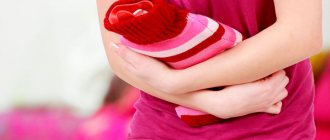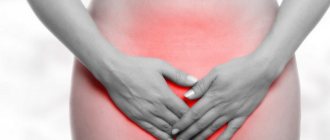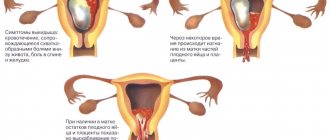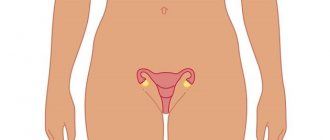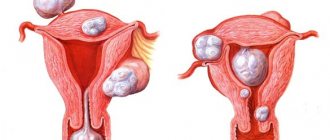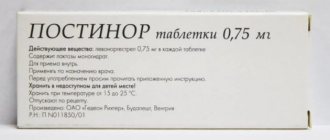Soon after returning from the maternity hospital, the young mother begins to think about the issue of contraception. Not every woman wants to experience the joy of motherhood again in the near future. The first menstruation signals the restoration of her reproductive function. However, ovulation after childbirth can occur even before the onset of menstruation. In order to recognize “dangerous days” in time, it will be useful to know about the signs of ovulation and the timing of its onset after childbirth.
When does ovulation occur after childbirth?
Ovulation is the release of an egg from a mature follicle. Over the course of 2-3 days during ovulation, the egg moves through the fallopian tube towards the uterus. All this time it is available to the sperm. And if she meets him, fertilization will occur and pregnancy will occur.
The timing of ovulation depends on the length of a woman’s cycle. Typically, the egg is released from the follicle 14 days before the onset of menstruation. But due to hormonal changes after pregnancy and childbirth, the timing of ovulation shifts in an unknown direction. First of all, it depends on whether the mother is breastfeeding or the baby is artificial.
If mom is breastfeeding
During breastfeeding, the mother's body produces the lactation hormone prolactin. It is responsible for milk production and suppresses ovulation. The resumption of the menstrual cycle in breastfeeding mothers occurs later than in those who do not breastfeed.
Only 5% of breastfeeding women get their periods within the first 6 months after giving birth. For the remaining majority, menstruation resumes after the end of lactation (or 6-12 months after childbirth).
It is difficult to say exactly when the first ovulation will occur in a nursing woman. The timing may vary: after 6 months, after a year and a half or after the end of breastfeeding.
It would seem that this is great news and you don’t have to think about contraception. However, not everything is so simple and unambiguous. The lactational amenorrhea (LAM) method, when a high level of prolactin does not give a chance for egg maturation, is a very unreliable method of protection.
In order to rely on it, several rules must be strictly observed:
- Breaks between feedings are no more than 3-4 hours;
- Night feedings are required;
- You can’t give your baby extra water;
- The child is no more than 6 months old;
- Exclusive breastfeeding.
Only if these conditions are met can we talk about the reliability of the MLA.
Norms and deadlines
The mother pays attention to the baby after birth. Household chores take center stage, and the return of female functions is not noticed. Ovulation is considered the first step towards conception. Without knowing when this will happen, the pregnancy will not be planned.
General standard. Normally, ovulation occurs in the middle of the menstrual cycle. The formation and development of the baby makes adjustments to the mother’s body. Problems occur during conception.
When does ovulation resume after childbirth? According to the norm for 45 days. However, the maturation time of the egg stretches from 25 to 72 days. Remember to take precautions to avoid unwanted consequences.
While breastfeeding. During lactation, a woman places her baby at intervals of 3-4 hours. The body produces sufficient amounts of a hormone that inhibits the onset of ovulation. Six months later, when complementary feeding begins, the chances of getting pregnant increase. How long does it take for ovulation to occur after childbirth depends on feeding, emotional state, and workload.
Normal birth. If labor takes place naturally, the mother does not breastfeed the baby, ovulation may occur within 6 weeks. By this time, the release of lochia will end, the body will be cleansed of the substances necessary to support the baby. The egg is released before your period, so don't worry about infertility.
After a caesarean section. During labor, the function of childbirth is disrupted. Mothers note that painful ovulation occurs after childbirth. The cause is the hard shell. The egg tries to come out, makes an effort. Hence the pain syndrome.
At the end of the cycle. There are cases of conception before the onset of subsequent periods. This phenomenon occurs after the end of labor. Menstruation is still returning, but with disruptions. The second period after childbirth passes without delay. The egg, having been fertilized, spends some time in the tube and, on the eve of the next cycle, goes into the uterine cavity.
No periods. Conception can occur when the ovulation process before the first menstruation after childbirth is finally restored. There may not be any bleeding afterwards. A woman enters into unprotected sexual contact, hoping for the saving role of breastfeeding and the absence of menstruation. The likelihood of an unwanted pregnancy is high. For some women, it happens 6–8 weeks after the end of the previous labor process.
During the recovery period, periods will be irregular, with a volume that does not match prenatal levels. The final establishment of the cycle depends on the emotional state of the woman, the ecology of the area, and the characteristics of the body.
How to calculate and determine ovulation after childbirth
Due to hormonal changes after pregnancy, it is almost impossible to accurately calculate the day of ovulation. However, there are some signs and methods for identifying dangerous days that you can focus on at least approximately.
Methods for determining ovulation
- Ovulation test Special test strips can be purchased at the pharmacy. The test reacts to the content of luteinizing hormone in urine or saliva. A positive result indicates the beginning of the fertile period.
- Basal temperature is a fairly reliable way to determine days favorable for conception. But it is difficult to use for a woman after childbirth. It is necessary to measure the temperature in the anus every day for several weeks without getting out of bed. Fluctuations in the basal temperature graph indicate the days of ovulation.
- Folliculometry Follicle maturation is monitored using ultrasound. It is necessary to visit a gynecologist several days in a row on the expected days of ovulation and have an ultrasound of the follicle.
All these well-known methods of controlling ovulation are unlikely to be suitable for a woman after childbirth. For the reason that hormonal levels do not stabilize immediately. And even after the cycle resumes, menstruation may be irregular in the first months after childbirth.
Signs of ovulation
Many women during the ovulation period experience a certain set of symptoms that can be used to recognize the release of the ovary from the follicle. In this case, subjective sensations may be more reliable than other methods. But at the same time, a woman must listen to herself very carefully.
- Abdominal pain Nagging pain in the lower abdomen on the right or left indicates the release of the egg from the follicle. The painful sensations are not significant: slight stretching, tingling or heaviness in the lower abdomen.
- Sensitivity of the mammary glands The day before or on the day of ovulation, the production of hormones that stimulate follicle maturation stops. And the synthesis of hormones that support the corpus luteum begins. This affects the condition of the breast. The nipples become sensitive and painful.
- Increased libido The release of the egg from the follicle leads to increased sexual desire. This happens at the hormonal level.
- Vaginal discharge The onset of ovulation can be judged by the consistency of the discharge from the cervix. For easy penetration of sperm into the uterine cavity, the cervical mucus thins and becomes similar to egg white.
- Edema Hormonal changes during ovulation lead to fluid retention in the body. This is expressed in swelling of the legs, arms, and face.
If you don't breastfeed, ovulation may happen faster
Gynecologists say that the possibility of ovulation occurring in the first 6 weeks after birth is minimal. Because at this time women experience postpartum bleeding. The body is cleansed of excesses that were necessary during pregnancy to provide the fetus with everything it needs. Usually, these discharges last for at least two to three weeks.
In addition, if menstruation has not resumed, and two or three months have passed since the birth, then it is better to undergo an ultrasound examination, check your health and check with a specialist whether ovulation has already occurred in the body. You can also use ovulation tests, but using this method in the absence of menstruation is difficult and expensive.
If a woman, for various reasons, does not breastfeed her baby after giving birth, then ovulation can occur 8-10 weeks after birth.
Therefore, women who do not want to become pregnant soon after their first birth should carefully approach the issue of contraception. And monitor the onset of ovulation, choose a reliable method of protection against unwanted pregnancy and do not believe common misconceptions that you cannot get pregnant immediately after childbirth, that sex is safe in the absence of menstruation. Because these are just assumptions, and each body is individual and determines when to resume fertility.
Painful ovulation after childbirth
Women often complain that after childbirth, the release of the egg from the follicle is painful. Although this was not noticed before the birth. As a rule, those who have experienced a caesarean section complain about this. Pain during ovulation occurs due to thickening of the ovarian lining, which is a consequence of surgery. At the moment of release from the ovary, the egg breaks through this thin barrier.
You can reduce the pain of ovulation if you take measures to eliminate adhesions formed in the abdominal cavity.
Ovulation calculation
If menstruation has not returned, it will be difficult to calculate the first ovulation after childbirth. Personal feelings can let you down due to changes; proven methods help with this.
Calculation methods:
- testing;
- temperature measurement;
- Ultrasound.
Tests are purchased at pharmacy kiosks. They help determine how long it will take for ovulation to occur after childbirth without menstruation. The principle of operation is based on counting strips that show how many sex hormones are in the urine. After reading the instructions, the woman will know when to expect conception.
Basal temperature should be at the same level every day. Appearing deviations indicate the readiness of the egg for fertilization. Measurements must be taken accurately. They are done after waking up, when the woman has not yet gotten out of bed. Record the indicators.
Ultrasound examination allows you to most accurately determine the date of ovulation without menstruation after childbirth. The gynecologist sees the shape of the follicle. He will tell you with up to 100% confidence when a breakup will occur, or whether this event has already happened.
When does ovulation occur after childbirth? Everyone is different. For some, at the end of the lactation period, others notice the first signs after 2-3 weeks after being discharged from the maternity hospital. Complete restoration of reproductive function takes from six months to 2 years. Breastfeeding delays the onset of ovulation after childbirth. Progesterone is produced when the baby is latched quite frequently. It slows down the process of follicle formation.
What causes heavy periods with pain?
The normal course of pregnancy and a successful birth bring a woman only positive changes occurring in the body. The enlarged uterus after childbirth takes on its natural position and original shape, due to which the pain during menstruation becomes weaker and soon subsides. But in some cases, deviations from the normal state are possible, when menstruation does not come at the scheduled time or comes, but with some deviations from the norm.
Such changes make it possible to suspect hormonal imbalances, which can be eliminated with the help of a specialist. A common occurrence in the postpartum period is heavy menstruation, which is accompanied by pain.
When controlling this condition, you first need to pay attention to the duration of menstruation and the volume of blood lost, as well as its color and existing impurities. If mucus, fragments of foreign tissue or a yellowish-green color can be detected, this is a symptom of inflammation or a purulent infectious process
This condition requires emergency medical attention.
The cause of pain during menstruation may be as a result of damage to the walls of the uterus during childbirth. As the injured areas heal, pain symptoms will begin to decrease.
When does complete restoration of the menstrual cycle occur?
Ovulation after childbirth with menstruation occurs differently for each female body. The cycle recovery period for nursing mothers can vary from 6 months to 2 years of age. However, in 8% of women, sometimes the duration of the return of menstruation exceeds 2 years. Everything again depends on the individual characteristics of the new mother. So, for example, if previously a woman could not worry about pregnancy during the entire lactation period, today reproductive function can resume during breastfeeding. This is due to stress, the environment, and temporary use of contraceptives.
Most women after childbirth believe that if they don’t have periods, then it’s impossible to get pregnant. However, the above information refutes this theory. Therefore, you should not forget about contraceptive methods even after childbirth.
Date: 10/30/2016
ovulation while breastfeeding
(maybe you need to be patient and read to the end)
Oh, this is a very burning topic!!! Of course, now you won’t surprise many people (or you will surprise them even more...
